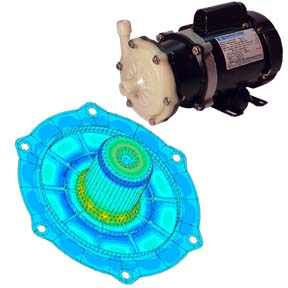Search Case Studies
End-Use Case Study
- Glass fiber reinforced polypropylene adds stiffness and minimized deflection
- Compatible with broad range of fluid and chemicals
- Moldflow and Finite Element Analysis (FEA) identified additional support geometry requirements
 March Manufacturing introduced the first magnetically coupled pump in 1963. Since then, they have supplied OEM’s throughout the world with the leak-proof design that eliminates seals and their maintenance. Specializing in non-metallic pumps for use with corrosive chemicals, acids, or solvents, March has built an impressive knowledge base in both plastic materials and injection molding. When developing their new 335 Magnetic Induction unit, March drew on this knowledge to increase prototype accuracy and meet an ambitious “to market” schedule.
March Manufacturing introduced the first magnetically coupled pump in 1963. Since then, they have supplied OEM’s throughout the world with the leak-proof design that eliminates seals and their maintenance. Specializing in non-metallic pumps for use with corrosive chemicals, acids, or solvents, March has built an impressive knowledge base in both plastic materials and injection molding. When developing their new 335 Magnetic Induction unit, March drew on this knowledge to increase prototype accuracy and meet an ambitious “to market” schedule.
March has relied on RTP Company to provide materials for many projects and selected an RTP 100 Series glass reinforced polypropylene compound for the new pumps’ housing sections. Chemically coupled, the material features an enhanced bond between the reinforcing fiber and the resin matrix. Sure of their material choice, March sought the same degree of security for the design. RTP Company’s computer aided engineering (CAE) team performed design reviews including mold flow and finite element analyses (FEA). The housings are subject to applied pressures of 80 psi (0.55 MPa) while in use and the clearance tolerance is tight—about 0.030 in (0.76 mm). This constitutes a truly “deflection critical” application.
The FEA determined that, when exposed to maximum operating head pressure, there would, indeed, be interference with the pumps’ internal moving parts. March and RTP Company engineers discussed remedies, including changes in gusset geometry and limiting unsupported areas. Further analysis indicated that recommended alterations would cut deflection to 0.0080 in (0.20 mm) vertically and a scant 0.0015 in (0.04 mm) on the radial axis. These movements are well within tolerances and were calculated at 1.5 times normal operating pressure, allowing for a generous safety margin.
March engineer Mike Wasserman notes that empirical evidence is the ultimate proof, but the early CAE involvement “allowed adjustments to be made in the computer room, rather than in the tool room.” He continued, “The monetary savings are significant, but eliminating unforeseen delays was even more valuable.”
According to Robert Sherman, RTP Company’s CAE manager, the technology’s capabilities are often used for basic purposes, such as troubleshooting. Properly utilized CAE can eliminate the need to incorrectly assume isotropic behavior and other non-variable properties.
Wassermann summed up the value of the CAE assistance when he stated, “These capabilities allowed us to build this mold—and future molds—confidently. We did not need to compromise strength and stiffness for proccessability, but we did need to balance them.” He continued, “This is where the FEA and flow analyses really worked together and helped us to provide accurate timing and performance estimates to both our marketing people and to our customers. We put our product on the market with no material changes, no mold changes, and no scheduling changes.”
March Manufacturing, Inc. manufactures magnetic drive pumps from their facilities in Glenview, IL. For more information visit their website at www.marchpump.com




